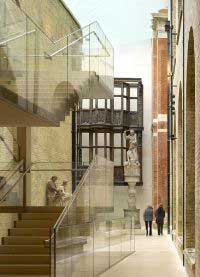Hub staircase at the V&A museum relies on DuPont™ SentryGlas® for the strength and appearance of its balustrades

Photo a: Alan Williams Photography <br>By combining the very thin landings and slender columns with cantilevered glass balustrades made with SentryGlas® interlayer, the visual impact of The Hub staircase at the Victoria & Albert Museum in London is reduced and its transparency is increased.<br>
The new Daylit gallery is a key component of the relocated and refurbished Medieval and Renaissance Galleries at the V&A, a project designed by UK architects MUMA working with restoration specialist Julian Harrap Architects. The new galleries occupy ten rooms in the south-east corner of the V&A, which had previously been isolated from the rest of the building and lacked physical and visual connections to the adjacent galleries. By removing an existing marble staircase, the architects were able to use the space between the old and new galleries to create the new Daylit gallery and, at one end of the space, a new lift and staircase, called The Hub, to connect various levels of the museum.
Standing clear of existing walls, The Hub staircase was engineered by the London-based office of structural engineers Dewhurst MacFarlane with very thin landings and slender columns, and was cast on site in reinforced concrete. Combined with the cantilevered glass balustrades, with each panel consisting of two 10 mm tempered glass sheets with a 1.52 mm layer of SentryGlas® interlayer, the overall effect is to reduce its visual impact and increase its transparency. The unobtrusive appearance of the glass balustrades was further enhanced by the unique fixing mechanism developed to secure the glass panels to the staircase.
DuPont™ SentryGlas® interlayer was specified by Dewhurst MacFarlane due to its recognized ability to create highly resilient laminates with extremely high post breakage performance. Working with the balustrade subcontractor TP Aspinall & Sons of Heysham (UK), the balustrades were designed and tested according to British Standards BS 6180:1999 for barriers in and about buildings and BS 6399-1:1996 for loading in buildings, amongst others. For example, two alternative designs – one produced using SentryGlas® interlayer, the other using a standard PVB glass foil to laminate the glass – were tested by the Dutch company Octatube International BV to determine their ability to withstand both static and dynamic loads. “The laminated glass panels made with SentryGlas® passed both of the tests, while the PVB alternative had already failed during static loading, making a subsequent dynamic load test superfluous,” recalls Simon Aspinall, director at TP Aspinall & Sons.
During the pendulum test used to determine the impact resistance of the balustrade design under dynamic loads, the inside panel of the laminate made with SentryGlas® was observed to break on initial impact. Yet the outside panel was undamaged and the glass panel itself remained safely in place, even after a second pendulum test, leading to a positive overall result. “Such findings confirm our own experience from various projects over the last 4 to 5 years that SentryGlas® interlayer is much stronger than a conventional PVB interlayer,” confirms Scott Nelson of Dewhurst MacFarlane. “Its big advantage is that, unlike other interlayers, it performs as a tensile membrane, meaning that it is able to retain a load bearing capacity even if one or both of the panels should break.”
SentryGlas® interlayers are 5 times stronger and approximately 100 times stiffer than PVB. As a consequence, there is almost perfect load transmission between the laminated glass sheets, resulting in laminates made with SentryGlas® demonstrating less than half of the deflection rate of comparable PVB laminates when the same load is applied. Moreover, SentryGlas® laminates show excellent post-glass breakage performance due to the strength of of the interlayer. Upon impact, the glass may break, but dangerous fragments will adhere to the SentryGlas® interlayer, reducing the risk of injury to passers-by. Because of the post-glass breakage performance, it provides continuing protection and resistance to entry or fallout and, in the case of a glass balustrade, its role as a barrier is maintained.
DuPont Glass Laminating Solutions provides materials, services and innovations to makers and specifiers of laminated glass. It helps create a better world by improving home protection and automotive safety, and enabling design of stronger, more energy-efficient buildings that let in more natural light.
DuPont is a science-based products and services company. Founded in 1802, DuPont puts science to work by creating sustainable solutions essential to a better, safer, healthier life for people everywhere. Operating in more than 70 countries, DuPont offers a wide range of innovative products and services for markets including agriculture and food; building and construction; communications; and transportation.
The DuPont Oval, DuPont™ and SentryGlas® are registered trademarks or trademarks of E. I. du Pont de Nemours and Company or its affiliates.
GLS-EU-2010-01
Editorial Contact:
Birgit Radlinger
Tel.: +49 (0) 61 02/18-2638
Fax: +49 (0) 61 02/18-1318
birgit.radlinger@dupont.com
Media Contact
More Information:
http://www.dupont.comAll latest news from the category: Architecture and Construction
Newest articles

NASA: Mystery of life’s handedness deepens
The mystery of why life uses molecules with specific orientations has deepened with a NASA-funded discovery that RNA — a key molecule thought to have potentially held the instructions for…

What are the effects of historic lithium mining on water quality?
Study reveals low levels of common contaminants but high levels of other elements in waters associated with an abandoned lithium mine. Lithium ore and mining waste from a historic lithium…

Quantum-inspired design boosts efficiency of heat-to-electricity conversion
Rice engineers take unconventional route to improving thermophotovoltaic systems. Researchers at Rice University have found a new way to improve a key element of thermophotovoltaic (TPV) systems, which convert heat…



